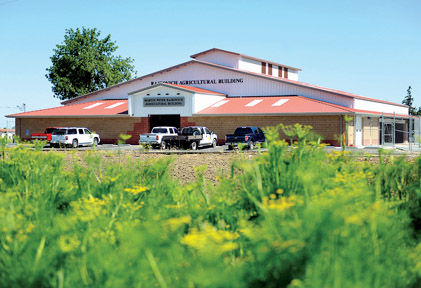
New high school ag barn is a hit with animals and students
On Wednesday, Paul Cardinalli and others in the high school’s
agriculture program were weighing their pigs at the new barn. From
20 pens lined in four rows of five, they had to move the swine from
their more comfortable caged confines to the weighing station on
the other end of the barn. Their choices were limited: Either
coerce the pigs toward the scale using square-shaped hog boards, or
go the more direct route by picking them up and taking your chances
with hearing loss.
New high school ag barn is a hit with animals and students
On Wednesday, Paul Cardinalli and others in the high school’s agriculture program were weighing their pigs at the new barn. From 20 pens lined in four rows of five, they had to move the swine from their more comfortable caged confines to the weighing station on the other end of the barn. Their choices were limited: Either coerce the pigs toward the scale using square-shaped hog boards, or go the more direct route by picking them up and taking your chances with hearing loss.
Fortunately, the new, much- larger barn provided plenty of room for hog-board users to maneuver their livestock, one by one, toward the enclosed scale. Unfortunately for Cardinalli when he picked up a pig for the long haul, his little pink friend wasn’t too happy about the trip and screamed about as loud as the 10 most stubborn choir-singing toddlers on Earth – combined.
For Cardinalli and about 20 other students, it was merely part of doing their daily chores at the Martin Peter Rajkovich Agricultural Building. Even on a sweltering summer day, Cardinalli grinned his way to the scale and ignored the yelping pig, and all the others could do was laugh at the situation, because it obviously wasn’t a first and it won’t be a last.
“They’re louder than a jet,” agriculture instructor Kelly Bianchi quipped to one of the few parents watching on, in explaining the decibels reached by pigs when they choose to scream.
Bianchi is San Benito High School’s agriculture teacher. During these summer sessions, as students prepare for the county fair in October, Bianchi does what she calls “spot check” while supervising the students at morning and night when they do their chores.
Students such as Cardinalli, who just graduated but can show at the fair in the fall after finishing school, might just have more incentive to get those chores done, too, with the recent completion of the 14,500-square-foot, modernized barn, intended for students who don’t have access to their own farm equipment at home.
“This is way bigger. There’s way more space to use,” said Cardinalli, after lugging his pig.
He was comparing the new barn to the old one torn down two years ago, which had been at the same spot on the southwest end of campus where the school built a farm in 1959.
Paid for mostly through a $900,000 donation from the late Rajkovich, who wanted to see the county’s agriculture tradition live on for generations, it opened at the end of May, followed by a dedication and ribbon cutting June 9.
The barn Wednesday housed pigs, goats and sheep in the array of crimson-dyed pens. There also are pens for steer, but Bianchi said there weren’t any students with cattle this year. They have plans to hold rabbits and chickens at some point, too.
“We can house everything,” Bianchi said.
Cardinalli was one of the 204 students enrolled in the ag program last school year, and that number should only increase with the new barn, which has such modern amenities as a series of vents in the roof that provide open air when needed.
Cardinalli, who said he was introduced to the agriculture program at eighth grade “Preview Night,” mentioned another benefit to the new structure – not having to deal with unsightly clogs.
With the Rajkovich barn, he said, “We don’t have to clean the drain.”









